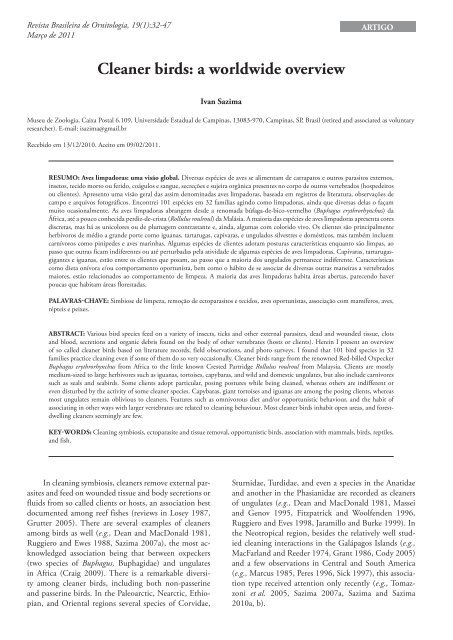Capa 19(1) - fechada.indd - Sociedade Brasileira de Ornitologia
Capa 19(1) - fechada.indd - Sociedade Brasileira de Ornitologia
Capa 19(1) - fechada.indd - Sociedade Brasileira de Ornitologia
Create successful ePaper yourself
Turn your PDF publications into a flip-book with our unique Google optimized e-Paper software.
Revista <strong>Brasileira</strong> <strong>de</strong> <strong>Ornitologia</strong>, <strong>19</strong>(1):32-47<br />
Março <strong>de</strong> 2011<br />
ARTIGO<br />
Cleaner birds: a worldwi<strong>de</strong> overview<br />
Ivan Sazima<br />
Museu <strong>de</strong> Zoologia, Caixa Postal 6.109, Universida<strong>de</strong> Estadual <strong>de</strong> Campinas, 13083‐970, Campinas, SP, Brasil (retired and associated as voluntary<br />
researcher). E‐mail: isazima@gmail.br<br />
Recebido em 13/12/2010. Aceito em 09/02/2011.<br />
Resumo: Aves limpadoras: uma visão global. Diversas espécies <strong>de</strong> aves se alimentam <strong>de</strong> carrapatos e outros parasitos externos,<br />
insetos, tecido morto ou ferido, coágulos e sangue, secreções e sujeira orgânica presentes no corpo <strong>de</strong> outros vertebrados (hospe<strong>de</strong>iros<br />
ou clientes). Apresento uma visão geral das assim <strong>de</strong>nominadas aves limpadoras, baseada em registros <strong>de</strong> literatura, observações <strong>de</strong><br />
campo e arquivos fotográficos. Encontrei 101 espécies em 32 famílias agindo como limpadoras, ainda que diversas <strong>de</strong>las o façam<br />
muito ocasionalmente. As aves limpadoras abrangem <strong>de</strong>s<strong>de</strong> a renomada búfaga-<strong>de</strong>-bico-vermelho (Buphagus erythrorhynchus) da<br />
África, até a pouco conhecida perdiz-<strong>de</strong>-crista (Rollulus roulroul) da Malásia. A maioria das espécies <strong>de</strong> aves limpadoras apresenta cores<br />
discretas, mas há as unicolores ou <strong>de</strong> plumagem contrastante e, ainda, algumas com colorido vivo. Os clientes são principalmente<br />
herbívoros <strong>de</strong> médio a gran<strong>de</strong> porte como iguanas, tartarugas, capivaras, e ungulados silvestres e domésticos, mas também incluem<br />
carnívoros como pinípe<strong>de</strong>s e aves marinhas. Algumas espécies <strong>de</strong> clientes adotam posturas características enquanto são limpas, ao<br />
passo que outras ficam indiferentes ou até perturbadas pela ativida<strong>de</strong> <strong>de</strong> algumas espécies <strong>de</strong> aves limpadoras. Capivaras, tartarugasgigantes<br />
e iguanas, estão entre os clientes que posam, ao passo que a maioria dos ungulados permanece indiferente. Características<br />
como dieta onívora e/ou comportamento oportunista, bem como o hábito <strong>de</strong> se associar <strong>de</strong> diversas outras maneiras a vertebrados<br />
maiores, estão relacionados ao comportamento <strong>de</strong> limpeza. A maioria das aves limpadoras habita áreas abertas, parecendo haver<br />
poucas que habitam áreas florestadas.<br />
Palavras-Chave: Simbiose <strong>de</strong> limpeza, remoção <strong>de</strong> ectoparasitos e tecidos, aves oportunistas, associação com mamíferos, aves,<br />
répteis e peixes.<br />
Abstract:Various bird species feed on a variety of insects, ticks and other external parasites, <strong>de</strong>ad and woun<strong>de</strong>d tissue, clots<br />
and blood, secretions and organic <strong>de</strong>bris found on the body of other vertebrates (hosts or clients). Herein I present an overview<br />
of so called cleaner birds based on literature records, field observations, and photo surveys. I found that 101 bird species in 32<br />
families practice cleaning even if some of them do so very occasionally. Cleaner birds range from the renowned Red-billed Oxpecker<br />
Buphagus erythrorhynchus from Africa to the little known Crested Partridge Rollulus roulroul from Malaysia. Clients are mostly<br />
medium-sized to large herbivores such as iguanas, tortoises, capybaras, and wild and domestic ungulates, but also inclu<strong>de</strong> carnivores<br />
such as seals and seabirds. Some clients adopt particular, posing postures while being cleaned, whereas others are indifferent or<br />
even disturbed by the activity of some cleaner species. Capybaras, giant tortoises and iguanas are among the posing clients, whereas<br />
most ungulates remain oblivious to cleaners. Features such as omnivorous diet and/or opportunistic behaviour, and the habit of<br />
associating in other ways with larger vertebrates are related to cleaning behaviour. Most cleaner birds inhabit open areas, and forestdwelling<br />
cleaners seemingly are few.<br />
Key-Words: Cleaning symbiosis, ectoparasite and tissue removal, opportunistic birds, association with mammals, birds, reptiles,<br />
and fish.<br />
In cleaning symbiosis, cleaners remove external parasites<br />
and feed on woun<strong>de</strong>d tissue and body secretions or<br />
fluids from so called clients or hosts, an association best<br />
documented among reef fishes (reviews in Losey <strong>19</strong>87,<br />
Grutter 2005). There are several examples of cleaners<br />
among birds as well (e.g., Dean and MacDonald <strong>19</strong>81,<br />
Ruggiero and Ewes <strong>19</strong>88, Sazima 2007a), the most acknowledged<br />
association being that between oxpeckers<br />
(two species of Buphagus, Buphagidae) and ungulates<br />
in Africa (Craig 2009). There is a remarkable diversity<br />
among cleaner birds, including both non-passerine<br />
and passerine birds. In the Paleoarctic, Nearctic, Ethiopian,<br />
and Oriental regions several species of Corvidae,<br />
Sturnidae, Turdidae, and even a species in the Anatidae<br />
and another in the Phasianidae are recor<strong>de</strong>d as cleaners<br />
of ungulates (e.g., Dean and MacDonald <strong>19</strong>81, Massei<br />
and Genov <strong>19</strong>95, Fitzpatrick and Woolfen<strong>de</strong>n <strong>19</strong>96,<br />
Ruggiero and Eves <strong>19</strong>98, Jaramillo and Burke <strong>19</strong>99). In<br />
the Neotropical region, besi<strong>de</strong>s the relatively well studied<br />
cleaning interactions in the Galápagos Islands (e.g.,<br />
MacFarland and Ree<strong>de</strong>r <strong>19</strong>74, Grant <strong>19</strong>86, Cody 2005)<br />
and a few observations in Central and South America<br />
(e.g., Marcus <strong>19</strong>85, Peres <strong>19</strong>96, Sick <strong>19</strong>97), this association<br />
type received attention only recently (e.g., Tomazzoni<br />
et al. 2005, Sazima 2007a, Sazima and Sazima<br />
2010a, b).

















